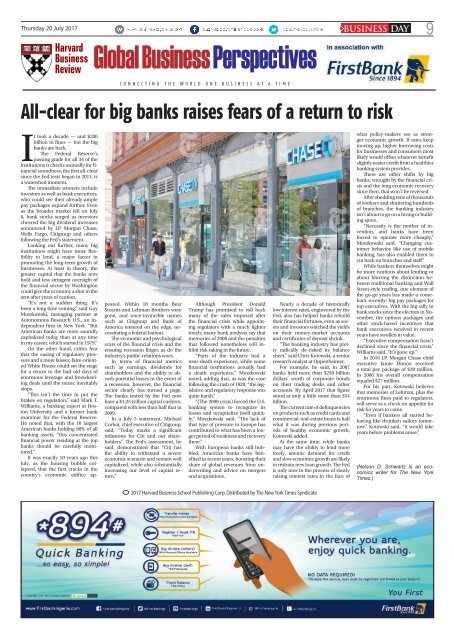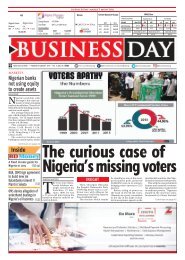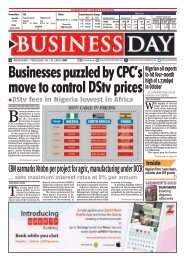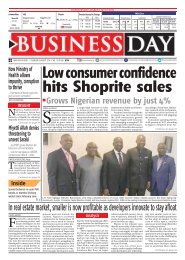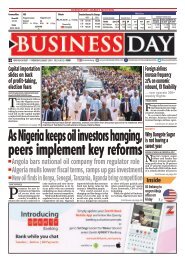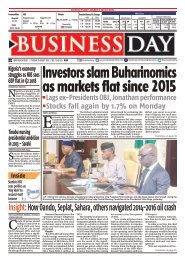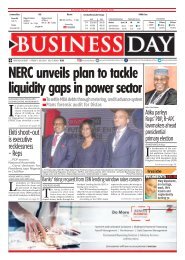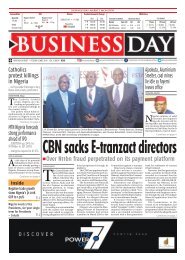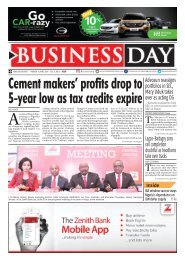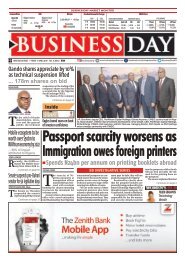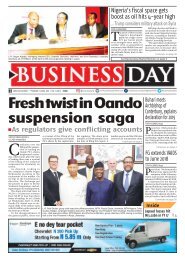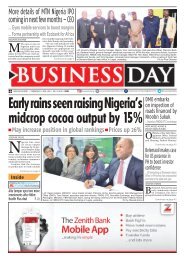BusinessDay 20 Jul 2017
You also want an ePaper? Increase the reach of your titles
YUMPU automatically turns print PDFs into web optimized ePapers that Google loves.
Thursday <strong>20</strong> <strong>Jul</strong>y <strong>20</strong>17<br />
Harvard<br />
Business<br />
Review<br />
Global Business Perspectives<br />
BUSINESS DAY<br />
9<br />
CONNECTING THE WORLD ONE BUSINESS AT A TIME<br />
All-clear for big banks raises fears of a return to risk<br />
The JPMor gan Chase bank branc h<br />
It took a decade — and $<strong>20</strong>0<br />
billion in fines — but the big<br />
banks are back.<br />
The Federal Reserve’s<br />
passing grade for all 34 of the<br />
institutions it checks annually for financial<br />
soundness, the first all-clear<br />
since the Fed tests began in <strong>20</strong>11, is<br />
a watershed moment.<br />
The immediate winners include<br />
investors as well as bank executives,<br />
who could see their already-ample<br />
pay packages expand further. Even<br />
as the broader market fell on <strong>Jul</strong>y<br />
6, bank stocks surged as investors<br />
cheered the big dividend increases<br />
announced by J.P. Morgan Chase,<br />
Wells Fargo, Citigroup and others<br />
following the Fed’s statement.<br />
Looking out further, many big<br />
institutions might have more flexibility<br />
to lend, a major factor in<br />
promoting the long-term growth of<br />
businesses. At least in theory, the<br />
greater capital that the banks now<br />
hold and less stringent oversight of<br />
the financial sector by Washington<br />
could give the economy a shot in the<br />
arm after years of caution.<br />
“It’s not a sudden thing. It’s<br />
been a long time coming,” said Guy<br />
Moszkowski, managing partner at<br />
Autonomous Research U.S., an independent<br />
firm in New York. “But<br />
American banks are more soundly<br />
capitalized today than at any time<br />
in my career, which started in 1979.”<br />
On the other hand, critics fear<br />
that the easing of regulatory pressure<br />
and a more laissez-faire-oriented<br />
White House could set the stage<br />
for a return to the bad old days of<br />
enormous leverage and freewheeling<br />
deals until the music inevitably<br />
stops.<br />
“This isn’t the time to put the<br />
brakes on regulation,” said Mark T.<br />
Williams, a banking expert at Boston<br />
University and a former bank<br />
examiner for the Federal Reserve.<br />
He noted that, with the 10 largest<br />
American banks holding 80% of all<br />
banking assets, “this concentrated<br />
financial power residing at the top<br />
banks should be carefully monitored.”<br />
It was exactly 10 years ago this<br />
<strong>Jul</strong>y, as the housing bubble collapsed,<br />
that the first cracks in the<br />
country’s economic edifice appeared.<br />
Within 18 months Bear<br />
Stearns and Lehman Brothers were<br />
gone, and once-invincible names<br />
such as Citigroup and Bank of<br />
America teetered on the edge, necessitating<br />
a federal bailout.<br />
The economic and psychological<br />
scars of the financial crisis and the<br />
ensuing recession linger, as do the<br />
industry’s public-relations woes.<br />
In terms of financial metrics<br />
such as earnings, dividends for<br />
shareholders and the ability to absorb<br />
potential losses in the event of<br />
a recession, however, the financial<br />
sector clearly has turned a page.<br />
The banks tested by the Fed now<br />
have a $1.25 trillion capital cushion,<br />
compared with less than half that in<br />
<strong>20</strong>09.<br />
In a <strong>Jul</strong>y 5 statement, Michael<br />
Corbat, chief executive of Citigroup,<br />
said, “Today marks a significant<br />
milestone for Citi and our shareholders.”<br />
The Fed’s assessment, he<br />
said, demonstrated that “Citi has<br />
the ability to withstand a severe<br />
economic scenario and remain well<br />
capitalized, while also substantially<br />
increasing our level of capital return.”<br />
Although President Donald<br />
Trump has promised to roll back<br />
many of the rules imposed after<br />
the financial crisis while appointing<br />
regulators with a much lighter<br />
touch, many bank analysts say that<br />
memories of <strong>20</strong>08 and the penalties<br />
that followed nonetheless will inhibit<br />
risk-taking in the future.<br />
“Parts of the industry had a<br />
near-death experience, while some<br />
financial institutions actually had<br />
a death experience,” Moszkowski<br />
noted, adding that, as was the case<br />
following the crash of 1929, “the legislative<br />
and regulatory response was<br />
quite harsh.”<br />
“(The <strong>20</strong>08 crisis) forced the U.S.<br />
banking system to recognize its<br />
losses and recapitalize itself quickly,”<br />
Moszkowski said. “The lack of<br />
that type of pressure in Europe has<br />
contributed to what has been a longer<br />
period of weakness and recovery<br />
there.”<br />
With European banks still hobbled,<br />
American banks have benefited<br />
in recent years, boosting their<br />
share of global revenues from underwriting<br />
and advice on mergers<br />
and acquisitions.<br />
Nearly a decade of historically<br />
low interest rates, engineered by the<br />
Fed, also has helped banks rebuild<br />
their financial fortunes, even as savers<br />
and investors watched the yields<br />
on their money-market accounts<br />
and certificates of deposit shrink.<br />
“The banking industry has pretty<br />
radically de-risked its balance<br />
sheet,” said Chris Kotowski, a senior<br />
research analyst at Oppenheimer.<br />
For example, he said, in <strong>20</strong>07<br />
banks held more than $250 billion<br />
dollars’ worth of corporate bonds<br />
on their trading desks and other<br />
accounts. By April <strong>20</strong>17 that figure<br />
stood at only a little more than $54<br />
billion.<br />
The current rate of delinquencies<br />
on products such as credit cards and<br />
commercial-real-estate loans is half<br />
what it was during previous periods<br />
of healthy economic growth,<br />
Kotowski added.<br />
At the same time, while banks<br />
may have the ability to lend more<br />
freely, anemic demand for credit<br />
and slow economic growth are likely<br />
to restrain new loan growth. The Fed<br />
is only now in the process of slowly<br />
raising interest rates in the face of<br />
what policy-makers see as stronger<br />
economic growth. If rates keep<br />
moving up, higher borrowing costs<br />
for businesses and consumers most<br />
likely would offset whatever benefit<br />
slightly easier credit from a healthier<br />
banking system provides.<br />
There are other shifts by big<br />
banks, wrought by the financial crisis<br />
and the long economic recovery<br />
since then, that won’t be reversed.<br />
After shedding tens of thousands<br />
of workers and shuttering hundreds<br />
of branches, the banking industry<br />
isn’t about to go on a hiring or building<br />
spree.<br />
“Necessity is the mother of invention,<br />
and banks have been<br />
forced to operate more cheaply,”<br />
Moszkowski said. “Changing customer<br />
behavior, like use of mobile<br />
banking, has also enabled them to<br />
cut back on branches and staff.”<br />
While bankers themselves might<br />
be more cautious about lending or<br />
about blurring the distinction between<br />
traditional banking and Wall<br />
Street-style trading, one element of<br />
the go-go years has made a comeback<br />
recently: big pay packages for<br />
top executives. With the big rally in<br />
bank stocks since the election in November,<br />
the options packages and<br />
other stock-based incentives that<br />
bank executives received in recent<br />
years have swollen in value.<br />
“Executive compensation hasn’t<br />
declined since the financial crisis,”<br />
Williams said. “It’s gone up.”<br />
In <strong>20</strong>16 J.P. Morgan Chase chief<br />
executive Jamie Dimon received<br />
a total pay package of $28 million.<br />
In <strong>20</strong>06 his overall compensation<br />
equaled $27 million.<br />
For his part, Kotowski believes<br />
that memories of Lehman, plus the<br />
enormous fines paid to regulators,<br />
will serve as a check on appetite for<br />
risk for years to come.<br />
“Even if bankers all started behaving<br />
like drunken sailors tomorrow,”<br />
Kotowski said, “it would take<br />
years before problems arose.”<br />
(Nelson D. Schwartz is an economics<br />
writer for The New York<br />
Times.)<br />
<strong>20</strong>17 Harvard Business School Publishing Corp. Distributed by The New York Times Syndicate


